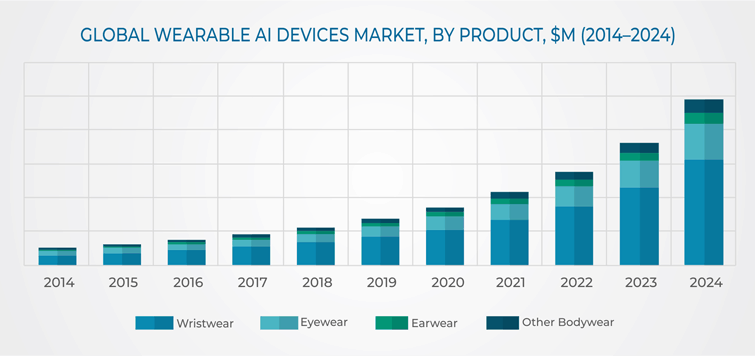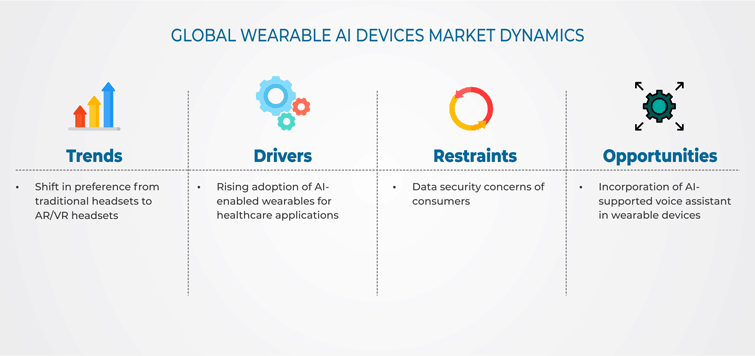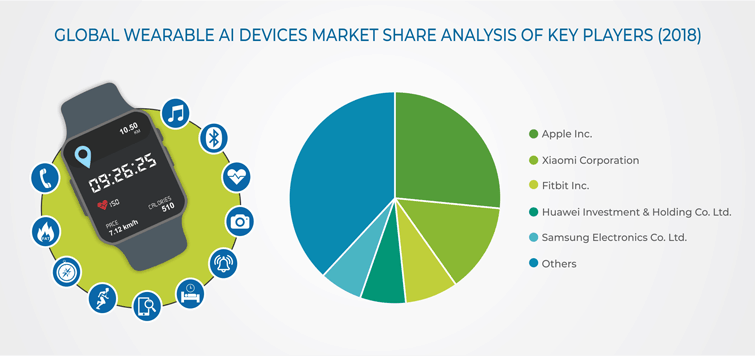Report Code: 11726 | Available Format: PDF | Pages: 156
Wearable AI Devices Market Research Report: By Product (Smartwatch, Fitness Band, Eyewear, Earwear), Component (Processor, Display, Connectivity IC, Power Management System, Sensors, Memory), End-User (Consumer Electronics, Healthcare, Gaming), Geographical Outlook (U.S., Canada, U.K., Germany, France, Russia, Italy, China, Japan, South Korea, India, Australia, U.A.E., Saudi Arabia, Turkey, South Africa, Brazil, Mexico) - Global Industry Size, Share Analysis and Trends Forecast to 2024
- Report Code: 11726
- Available Format: PDF
- Pages: 156
- Report Description
- Table of Contents
- Market Segmentation
- Request Free Sample
Market Outlook
The wearable AI devices market value was $11,182.8 million in 2018, and the market is predicted to progress at a CAGR of 29.0% from 2019 to 2024. The key factors driving the expansion of the market are the surging disposable income, rising consumer preference for next-generation wearable devices, growing usage of artificial intelligence (AI)-enabled wearables for healthcare applications, rapid technological developments in the consumer electronics industry, changing lifestyles, and mushrooming requirement for augmented reality/virtual reality (AR/VR) headsets.
The wristwear category dominated the market for wearable AI devices in 2018, under the product segment. This is credited to the huge requirement for wristwear equipped with AI functionalities, such as sleep tracking, personal voice assistance, and heart rate monitoring. The fitness band bifurcation of the wristwear category is predicted to exhibit the higher growth rate in the coming years.

The cloud category, within the deployment segment, led the wearable AI devices industry in 2018, and it is also predicted to demonstrate the faster growth in the forthcoming years. This is attributed to the surging demand for storing the data created in real time and data synchronizing in smart devices.
Globally, the wearable AI devices market was dominated by North America in 2018 on account of the high per capita income of the people here, existence of several consumer electronics firms offering advanced devices at affordable prices, and huge investments being made in technological advancements for boosting AI adoption in wearable devices in the gaming, healthcare, and consumer electronics industries.
In the upcoming years, the market will exhibit the highest growth rate in the Asia-Pacific (APAC) region because of the soaring requirement for wearable devices, especially in India and China, and increasing adoption of the AI technology in the wearable devices manufactured in the region.
Market Dynamics
With the growing penetration of smartphones and ballooning trend of cloud and mobile gaming, the demand for VR headsets is rising rapidly. Further, the value of the video games industry is predicted to rise from $76 billion in 2017 to $92 billion by 2020. Due to this factor, industry players are increasingly focusing on launching VR headsets that offer a better visual experience and sound quality and, consequently, enhance the overall gaming experience.
Thus, the soaring requirement for VR headsets is a major wearable AI devices market trend. For example, Oculus, which is a subsidiary of Facebook Inc. and a VR software and hardware provider, announced the launch of Rift S, which is a VR headset specifically built for gaming, in May 2019.
This headset is integrated with Oculus Insight, which is the company’s new tracking technology that uses five cameras incorporated in the headset for capturing the movements and location of the user. Moreover, with the help of the Passthrough+ feature, the cameras give wearers a glimpse of their real-world environment within the game.

One of the major market growth drivers is the soaring usage of AI-supported wearable devices in healthcare applications on account of the increasing consumer focus on health and fitness and rising public awareness about AI-powered wearables and the convenience offered by them. These devices allow users to monitor their sleeping and eating patterns and also recommend them the changes that they need to make in their routine for improving their fitness.
The players operating in the market are strongly focusing on launching AI-enabled wearables that can track users’ fitness activities. For example, Garmin Ltd., a leading wearable AI devices market player, developed Instinct, a smartwatch equipped with a barometric altimeter and GALILEO, GLONASS, and GPS satellite navigation capabilities, in October 2018.
Additionally, built-in wrist-based sensors allow users to track the number of steps taken, calories burned, and distance traveled and also monitor their stress levels. Therefore, the growing adoption of these devices for monitoring health is also supporting the market expansion.
Competitive Landscape
The wearable AI devices market is fragmented in nature, owing to the presence of a large number of established and small players. Companies in the market are primarily focusing on partnerships to increase their customer base and capture a larger market share. For instance, in January 2018, Xiaomi Corporation announced its partnership with Oculus to launch standalone VR headsets, including Oculus GO and Xiaomi Mi VR Standalone. Both the headsets utilize the Snapdragon mobile VR platform for high-processing requirements.

Some of the major players operating in the global wearable AI devices market are Fitbit Inc., Apple Inc., Xiaomi Corporation, Samsung Electronics Co. Ltd., Garmin Ltd., Huawei Investment & Holding Co. Ltd., Google LLC, Fossil Group Inc., Microsoft Corporation, Sony Corporation, and BRAGI GmbH.
Want a report tailored exactly to your business strategy?
Request CustomizationWant an insight-rich discussion with the report author?
Speak to AnalystOur dedication to providing the most-accurate market information has earned us verification by Dun & Bradstreet (D&B). We strive for quality checking of the highest level to enable data-driven decision making for you
Our insights into the minutest levels of the markets, including the latest trends and competitive landscape, give you all the answers you need to take your business to new heights
With 24/7 research support, we ensure that the wheels of your business never stop turning. Don’t let time stand in your way. Get all your queries answered with a simple phone call or email, as and when required
We take a cautious approach to protecting your personal and confidential information. Trust is the strongest bond that connects us and our clients, and trust we build by complying with all international and domestic data protection and privacy laws